
Sweating Treatment Page Menu: 1 2 3 4 5 Next>>
Sweating Humoral Treatment in the Golden Age of Piracy, Page 1
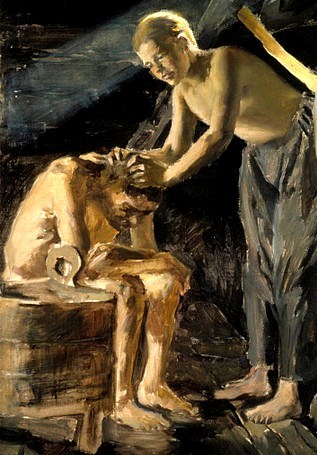
Artist: Akseli Gallen-Kallela - Sweating (1889)
“Now Inanition, or evacuation is no other thing than the expulsion or effusion of humors which are troublesome, either in quantity or quality. Of Evacuations, some are universall, which expell superfluous humors from the whole body such as purging, vomiting, transpiration, sweats, Phlebotomy.” (Ambroise Paré, The Workes of that Famous Chirurgion Ambrose Parey, 1649, p. 28)
Balancing the humors in the body was an integral part of health care in the golden age of piracy and is mentioned in most surgical procedures. When the removal of unwanted humors from the body is discussed, most people think of bloodletting (or phlebotomy as Paré calls it). Those who have looked into a little more are also likely to be aware of purging humors using enemas and vomiting. However, sweating and transpiration (a term sometimes used to refer to a less intense form of sweating, also referred to as a 'breathing sweat') are much less often associated with humor theory. Yet sweating was used by many physicians and surgeons to expel unwanted humors in dealing with a variety of health concerns during this period.
This article will examine the role of sweating as a humoral treatment in the late 17th and early 18th centuries. It begins with a look at the large variety of illnesses in which practitioners prescribed sweating. From there, the theory behind sweating as it relates to the body's humors is discussed. This is followed by a look at both natural and medicinally-created sweats and how each was viewed. Finally, the general procedure used to sweat men is explained, followed by a look at how sweating was used in three health problems where it was most popular - scurvy, fevers and syphilis (or the pox).
Medical Problems Where Sweating Was Used
Sweating was used by many different surgeons and physicians to address a number of health problems. While no one explains sweating as an individual process, they frequently mention them during the course of treatments where sweating was used. Surgeons promoted sweating using medicines that were called sudorifics or diaphoretics, choosing those they felt were appropriate to the health problem. Such medicines are mentioned in some of these procedures, most without in-depth explanation of their use. That can be found in the section on medicinal sweat later in this article.
While many medical men mention the use of sweating in procedures, this section will focus on its use at sea and by certain military surgeons who had served at sea during their career. Two health concerns where sweating was most discussed for use are discussed in their own sub-sections: fevers and syphilis (usually called the pox at this time.)

Military and Naval Surgeon Richard Wiseman
Famed late 17th century military and sometimes sea surgeon Richard Wiseman made sparing use of sweating in his treatments. He suggested that Irish slate be given to a patient with ecchymosis (bruising causing blood to collect under the skin), explaining that they would then be "disposed to a breathing Sweat [a gentle sweat accompanying regular breathing]"1. In a related entry, he advised patients with erysipelas (a skin infection resulting in large, raised red patches) to raise "a Sweat with a draught of Posset drink wherein had been boiled a little Harts horn, a few opening Roots and Marigold-flowers."2 (Posset drinks were cream-based, often with sugar, ale or wine and other flavor enhancers such as cinnamon or ginger and rose-water.) He also suggested the use of a multi-ingredient cure-all, the Countess of Kent's powder, for the same purpose.3
Wiseman also explains the cure of patients with gangrene who he notes had had their body 'over-cooled'. Such patients were given alcohol and multi-ingredient cure-alls, the primary diaphoretic element of which was typically opium, and then laid "by the Fire; but not too near" or put into 'a warm Bed' where they could sweat.4
French military surgeon Ambroise Paré made somewhat wider use of sweating in his cures than Wiseman. He recommended sweating to treat the gout by placing the 'gouty part' on danewort leaves (sambucus ebulus) pressed between heated tiles "and by sweat receiv the fruit thereof, for the space of an hour, substituting fresh Dane-wurt-leavs, if the Former becom too drie."5
In palsies Paré explained that "
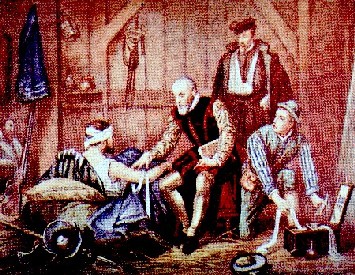
Artist: E. Hammond - Ambroise Paré Bandaging a Soldier
Guaiacum is very fit for this purpose, for it procures sweat and attenuates, digests and drieth up all the humidity which relaxeth the nerves"6.
For small pox, he advised "it is better to use sudorificks [sweat-causing medicines], which by attenuating [reducing the force of] the humors and relaxing the pores of the skin may drive the caus of the diseas from the center [of the body] to the circumference, which otherwise residing in the bodie might bee a caus of death"7.
Paré also recommended that sweating be used to treat poisoning by venomous beasts8, snakes9 and spiders10. In spider bites he treated the wound by bathing it "with verie hot vineger; then must you lay thereto Onions; and such like things beaten, then procure sweat by art, as by baths and stoves, yet nothing is more effectual than treacle and mithridate."
Sea surgeon Thomas Aubrey had a few suggestions for the use of sweating in illnesses contracted by African slaves. He is one of the few medical writers under study to recommend the use of diaphoretic medicines in diarrheas.11 While physician Thomas Sydenham said that enemetic medicine could cause a patient to "sweat of his own accord, (by reason of the Whey mixed with the Blood)", he doesn't recommend forcing the sweat via medicines like Aubrey does.
Aubrey is also one of the only surgeons to suggest sweating for the cure of pleurisy (inflammation of the lungs and chest cavity). He explains that the patient is to be bled first and then the surgeon "must have immediate recourse to Diaphoretics and Expectoratives [medicines to cause coughing and spitting], in order to eventilate [ventilate] the Blood, and compose and bridle the Orgasm of the Spirits, and to correct the vitiated [corrupted] Air, and renew the natural Diathesis [condition] of the Fluids."13

Sea Surgeon John Woodall
Sea surgeon John Woodall recommended sweating in several illnesses. He quoted classical physician Paracelsus' use of "Common sea salt, boyled in the strongest beere to the consumption of three parts of the same beere and being made salt as Brine" for use in gout, similar aches, rheumes (watery discharge in the eyes and nose) and skin diseases.14 The mixture was to be made "as warme as they can possible indure it, sit in it and sweat therein, and after go to a warm bed and sweat againe, and doing so sundry times, they shall feele helpe thereby."15
For men with gunshot wounds, Woodall advised "if he be strong, after he is dressed, you may lay him to bed to sweat, and procure him thereto by a dose of Diaphoreticon given in Trekel or Mithridate, regarding as is said that the sicke have the benefit of a naturall open body"16.
He said that when treating an aposteme or ulcer, diaphoretic medicines should be given "whilest he is yet in bed, and cover him warme, and yet but ordinarily, and it will cause him gently to sweat some 2 or 3 houres: then let him wipe himself and rise"17. Woodall also suggested sweating for treating swollen limbs caused by scurvy.18
The champion of sweating was sea surgeon John Moyle who advised its use to treat twenty different health problems. These included catarrhs [mucus build up in the nose or throat]19,
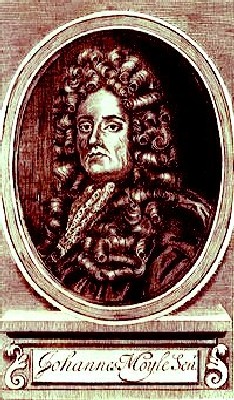
Sea Surgeon John Moyle
cricks in the neck20 and back21, near drowning22, pain and deafness in the ears23, pains, old aches and bruises, cramp and stiffness of sinews24, rib fracture or dislocation25, scurvy26, surfeits caused by drinking or eating too much27, problems of the throat28, toothaches (although he warned that "hollow, and rotten Teeth are best drawn out")29, penetrating wounds30, contused wounds of the limbs31, wounds of the joints and nervous parts32 and wounds of the head with a skull fracture.33
Like Richard Wiseman, Moyle advised that patients with gangrene "be caused to sweat; for without these you will scarcely stop the Gangreen, but that it will send its malignant Attoms to the Heart, and kill the Patient."34
With regard to rheumatism, Moyle said in 1686, "I could never find that Purging, or Sweating would do any good in this disease, but rather exasperate it"35. Seven years later, he had changed his opinion. Moyle explained that rheumatism arose from three different sources: drinking too much, being in the cold and wet and inward causes.36 For the first two causes, he advised that "Sweating here is of moment", suggesting that the patient be taken to a hot house "and there let him be Sweat and rub'd to purpose, and there let the parts be Cupt, and let good quantity of blood be drawn by Cupping and do not this only once, but twice; or thrice if occasion be, for this hath been known to Cure many."37
1 Richard Wiseman, Eight Chirurgicall Treatises, 3rd Edition, p. 70; 2 Wiseman, p. 40; 3 Wiseman, p. 41; 4 Wiseman, p. 438; 5 Ambroise Paré, The Workes of that Famous Chirurgion Ambrose Parey, 1649, p. 459; 6 Paré, p. 260; 7 Paré, p. 492; 8 Paré, p. 511; 9 Paré, p. 520; 10 Paré, p. 522; 11 Thomas Aubrey, The Sea-Surgeon or the Guinea Man’s Vadé Mecum., p. 78; 12 Thomas Sydenham, The Whole Works of Dr. Thomas Sydenham, 3rd ed, 1701, p. 124; 13 Aubrey, p. 56; 14 John Woodall, the surgions mate, 1617, p. 275; 15 Woodall, p. 275-6; 16 Woodall, p. 142; 17 Woodall, p. 157; 18 Woodall, p. 192; 19 John Moyle, The Sea Chirurgeon, 1693, p. 259; 20 Moyle, Sea Chirurgeon, p. 100; 21 John Moyle, Abstractum Chirurgæ Marinæ, 1686, p. 72; 22 Moyle, Sea Chirurgeon, p. 99; 23 Moyle, Sea Chirurgeon, p. 243-4; 24 Moyle, Abstractum, p. 72-3; 22 Moyle, Sea Chirurgeon, p. 103; 26 Moyle, Abstractum, p. 99-100; 27 Moyle, Abstractum, p. 107; 28 Moyle, Sea Chirurgeon, p. 238 & Moyle, Abstractum, p. 75; 29 Moyle, Abstractum, p. 76; 30 Moyle, Sea Chirurgeon, p. 81; 31 Moyle, Sea Chirurgeon, p. 89; 32 Moyle, Abstractum, p. 42; 33 Moyle, Sea Chirurgeon, p. 113; 34 Moyle, Sea Chirurgeon, p. 93-4; 35 Moyle, Abstractum, p. 71; 36 Moyle, Sea Chirurgeon, p. 220; 37 Moyle, Sea Chirurgeon, p. 221
Medical Problems Where Sweating Was Used - Fevers
No medical problem generated more discussion about the use of sweating as part of its cure than fevers. Entire books were written about the topic, presenting a variety of different theories about what caused fevers and how different types of fever could best be treated.1 Notable 17th century physician Thomas Sydenham advised that "no Man can tell by arguing, but [only] by experience, what kind of Fever can, and ought to be cured by Sweats, and what by other Evacuations."2
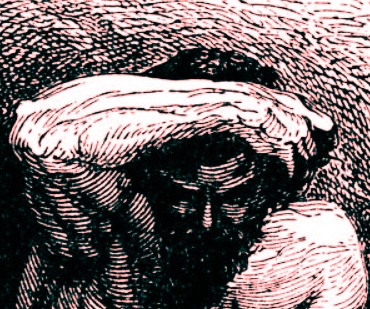
Artist: Gustav Dore - Detail from The Inferno, Canto 18 (1857)
Before examining recommendations for the use of sweating to treat fevers, some context will be helpful in understanding what 'fever' meant during this period. Today we simply think of a 'fever' as an elevated body temperature. However, it was more of blanket term which described a variety of health problems during the golden age of piracy.
Medical authors often differentiated between types of fevers, indicating how each affected a patient or the symptoms of the fever. This led to the creation of a wide variety of fevers being defined (with authors sometimes using different terms for the same type). The supplement to Emphraim Chambers 18th century Cylopædia says, "Riverius [17th century French physician Lazare Rivière] reckons above thirty different kinds of fevers, and [Thomas] Sydenham has increased them to double that number"3. Many of these fevers became known by other names after the golden age of piracy. Where possible, these more modern names will be indicated.
The most temporary of fevers was referred to as a Diary, or Ephemera - a fever that lasted for less than a day. This was most likely a low-grade fever which accompanied a stomach flu or similar illness. While Dutch physician Gideon Harvey generally dismissed the use of sweat-inducing medicines in fevers, he admitted that a patient "upon taking immediately in a Diary, some potent Diaphoretic, with the Assistance of a Load of Bed-cloathes [sheets and covers] they have soon fallen into a Sweat, which concluded hath wholly carried off the Fever"4. Sea surgeon John Woodall suggests sassafras water in what he refers to as 'colde' fevers5, which are likely low-grade fevers such as those that come with the flu or similar illnesses.
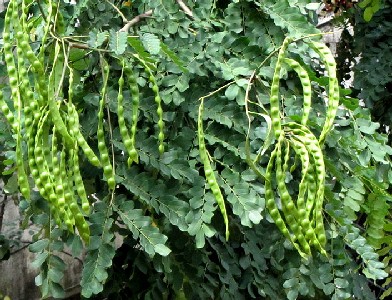
Photo: Sengai Podhuvan - Soymidia Febrifuga
Agues or intermittent fevers (malaria or similar tropical fevers) were often treated by sweating. Sea surgeon John Moyle explained his procedure for a patient with an 'intermitting fever': "at night when he turns in, give him of Aqua febrifuga [a compound water containing febrifuga [probably soymidia febrifuga, the bark of which has properties similar to quinine], lesser centaury, carduus benedictus, cinquefoil and wormwood] {2 or 3 ounces}, and sweat him upon it."6 Sea surgeon Thomas Aubrey also recommended sweating for intermittent fevers because it allowed the "noxious Corpuscles occasioning this Tragedy" to escape and "appear like little Globules of Dew all over the Body, which is commonly called Diaphoresis; and so the Fever is dissolved"7.
Although sea surgeon John Woodall doesn't directly recommend sweating in fevers, he does advise the use of medicines which caused sweating for intermittent fevers including antimony (stibium) in tertian fevers (malarial fevers which 
Artist: Mary Beale
Thomas Sydenham (late 17th c.)
recur every second day)8, water of the blessed thistle in quartan fevers [malarial fevers recurring every four days]9 and Oil of Poppies in general fevers.10
Thomas Sydenham employed sweating in tertian agues, advising that the patient be "put to Bed and well covered, ...sweat him with Sage Posset-drink, about four hours before the Fit comes, and as soon as he begins to sweat, ... give him two scruples of Pill. Coch. maj. [dissolved in a mixture of Aqua vitæ, Venice Treacle and English Saffron]... When he has taken these things, let the sweat be continued for some hours after the time wherein the Fit should come, taking great care of those interruptions of sweating, which perhaps Stools may occasion"11. He also said diaphoretic medicines "perform the Cure by promoting the Sweat coming at the end of the Fit, the Patient being well cover'd with Clothes, which must be continued as long as he can bear it", particularly for quotidian fevers (malarial fevers that recur every day).12
Curiously, Sydenham later warns, "it has now been well known to me for many Years, how dangerous a thing it [sweating] is in Tertians and Quotidians ...for tho’ it is very well known, that as soon as the Sweat breaks out, Restlesness and other Symptoms vanish immediately, and Apyrexy succeeds [the fever breaks], and therefore ...it must be indulged a little, at least not hindred"13. He felt that breaking the fever too soon would cause it to change from an intermittent to a continual fever "and the Life of the Sick is in a hazardous condition; one is saved, and the other dies"14.
John Moyle also advises sweating in calentures, which were fevers caused by the tropical heat (which may have actually been sunstroke). Moyle noted that they were "very frequent at Sea,
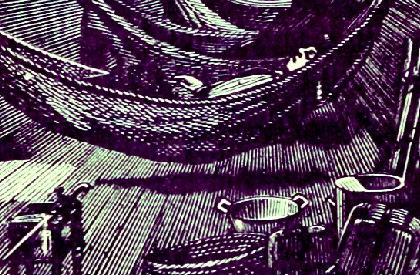
Artist: G. Bruno - A Man in a Hammock in His Cabine Shipboard
especially in hot Clymates."15 He first recommends 'burning' a pint of wine and mixing it with London Treacle for men so afflicted noting that "this (it may be) may hinder a further progress"16. In his later book, Moyle expands upon this treatment advising the surgeon to "order him into a warm Bed, (or if at Sea into his Cabbin) and let him be cover'd well, then give him a good Sudorifick" such as Venice or London treacle in burnt wine.17
Moyle extends such treatments to continual fevers - those lasting more than 24 hours. These were likely fevers that accompanied pneumonia or influenza. However, Moyle warns that "while Sweating hath taken the edge of the Distemper off from many at first, but if so be, that for all this, there comes a burning, and thirst, and pain increaseth, then you may conclude it will be a violent (if not malignant) Fever."18
Sydenham disagreed with sweating a patient by artificial means when he was suffering
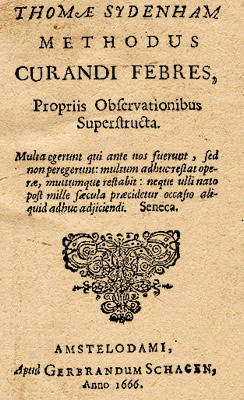
Thomas Sydenham's Book on Fevers
from a continual fever. He asks, "when it [a fever] does not come of it self, how can we certainly tell that we may not kill the Man, whilst we endeavour to dispose the Humours to Sweat by a hot Regimen, and hot Cordials?"19 He repeats this idea that natural sweat is the only valuable type of sweat in a continual fever while medicinally-created fevers are not several times.20
Sydenham is in favor of encouraging sweating in what he refers to as pestilential fevers - such as the type which accompany typhus and the bubonic plague. He insists upon this point, noting that alexipharmic medicines - those prescribed to cure poisonings - work "only by accident, viz. by the benefit of Sweat they produce"21. John Woodall likewise prescribes the sudorific medicine salt of wormwood in what he calls 'contagious fevers'.22
The key to using diaphoretic medicines to sweat patients in pestilential fevers appears to have been believed to be when they were administered according to several contemporary authors. Sea surgeon Thomas Aubrey advises, "When Pustles appear administer Cardiacs [a medicine beneficial to the heart which "raises the Spirits, and gives sudden Strength and Cheerfulness" to the patient23], and Diaphoretics in a moderate way"24. Sydenham recommends that sweat be procured after bleeding the patient, for "sweat is easily and soon raised... [and] abundantly compensates the loss of Blood, which, how little soever it be, would otherwise be very injurious."25
1 For just a few of the many examples of such books, see Edward Strother, Criticon febrium, or, A critical essay on fevers, 1716; James White, De recta sanguinis missione, or new and exact observations of fevers, 1712; George Cheyne, A new theory of continu'd fevers, 1701 and Andrew Brown, A vindicatory schedule, concerning the new cure of fevers, 1691; 2 Thomas Sydenham, The Whole Works of Dr. Thomas Sydenham, 3rd ed, 1701, p. 436; 3 "Fevers", A Supplement to Mr. Chambers's Cylopædia, Vol. 1, 1753, not paginated; 4 Gideon Harvey, The Vanities of Philosophy and Physic, 2nd ed, 1700, p. 70-1; 5 John Woodall, the surgions mate, 1617, p. 56; 6 John Moyle, Abstractum Chirurgæ Marinæ, 1686, p. 122; 7 Thomas Aubrey, The Sea-Surgeon or the Guinea Man’s Vadé Mecum., p. 42; 8 Woodall, p. 111; 9 Woodall, p. 73; 10 Woodall, p. 97; 11 Sydenham, p. 46; 12 Sydenham, p. 46; 13,14 Sydenham, p. 222; 15 Moyle, Abstractum, p. 115; 16 Moyle, Abstractum, p. 116; 17 John Moyle, The Sea Chirurgeon, 1693, p. 156-7; 18 Moyle, Sea Chirurgeon, p. 159; 19 Sydenham, p. 160; 20 For examples, see Sydenham, p. 108 & 158; 21 Sydenham, p. 66; 22 Woodall, p. 286; 23 John Quincy, Pharmacopoeia Officinalis & Extemporanea, 1719, p. 77; 24 Aubrey, p. 27; 25 Sydenham, p. 73
Medical Problems Where Sweating Was Used - The Pox
The Pox or 'morbus venerus' referred to venereal diseases such as syphilis and gonorrhea, since they were thought to be different phases of the same illness by many authors from this period. Of gonorrhea, sea surgeon John Moyle explains "we call but a Clap: Howbeit, it is really the Pox, (a Chip of the same Block) and there is no other difference then [between them] only in the Major and Minor."1
When treating the pox, sea surgeon Moyle advises a regimen of purging alternated with
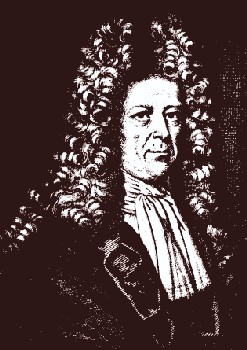
Author Joannes Sintelaer (1709)
sweating. He says, "When you would sweat [a patient], to some of your dyet-drink add a spoonful of Spir. Guaic. [spirit of guaiacum; guaiacum causes sweating] and make him sweat powerfully, for by this way of purging and of sweating we usually Cure the Pox at Sea."2 John Woodall doesn't go into detail on ways to cure the pox in his book, but he does note that Guaiacum purges the body "and doth wonderfully cure the morbius Gallicus [pox]"3. He recommends a variety of other sweat-inducing medicines for the pox including oil of poppies4, China roots5, sarsaparilla6 and sassafras water7.
In his book The Scourge of Venus and Mercury, physician Joannes Sintelaer discusses the diagnosis and treatment of the pox. Sweating features importantly in his work. "We will begin with the several Ways of raising the Sweat in this Disease, which being so highly necessary to expel that mortal Enemy of our Constitution out of his lurking Holes, must be promoted and managed with all possible Dexterity and to the utmost Advantage."8 Although he goes into detail about each of his various methods for sweating a pox-laden patient, they are left for the section on sweating procedures in this article.
French military surgeon Ambroise Paré employed sweating in treating gonorrhea, which, as we have seen, were considered by many to be a part of the pox at this time. Among his advice for treatment of this disease was "strong exercises do good, as the carrying of heavie burdens even until they sweat"9.
1 John Moyle, The Sea Chirurgeon, 1693, p. 137; 2 John Moyle, Abstractum Chirurgæ Marinæ, 1686, p. 93; 3 John Woodall, the surgions mate, 1617, p. 98; 4 Woodall, p. 58 [erroneously paginated as 44 in the original text]; 5 Woodall, p. 97; 6 Woodall, p. 97-8; 7 Woodall, p. 56; 8 Joannes Sintelaer, The Scourge of Venus and Mercury, 2nd ed,, 1709, p. 230; 9 Ambroise Paré, The Workes of that Famous Chirurgion Ambrose Parey, 1649, p. 478

